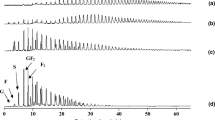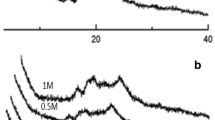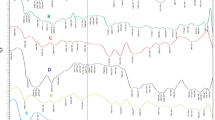Abstract
The thermal analyses and the water state diagrams of agavin and inulin were investigated. The thermogravimetric analysis and differential scanning calorimetry (DSC) were used to know the difference between fructans. Linear inulin (220.0 °C) showed a higher thermal stability than the branched agavins (206.7 °C). The samples displayed different physical states and lightness depending on the water activity of storage (a w). The agavin showed different physical states: powder (a w < 0.33), soft lump (a w ≈ 0.43), sticky (0.55 < a w < 0.77), and liquid (a w > 0.85), while inulin showed two physical states: an amorphous powder at a w < 0.55 and a semicrystalline solid at a w > 0.69. These physical states decreased the lightness of fructans. The GAB equation and the Gordon–Taylor equation showed a good fit to the experimental data (R 2 > 0.95). The K constant of GAB equation predicted a lower water affinity of inulin powder, while the agavin powder presented a higher water affinity. The DSC showed a glass transition temperature of 118.1 and 135.3 °C for agavin and inulin anhydrous powders, respectively. An increase in water content in agavin showed a higher depression in the glass transition temperature than in inulin. Also, the inulin exhibited a melting point while agavin not. The water state diagrams showed the critical water activity at which the agavin (0.50) and inulin (0.59) powders were stable to physical changes. This knowledge is used to understand the physical and structural behaviors of agavin and inulin at the different water activities.



Similar content being viewed by others
References
Kaur N, Gupta AK. Applications of inulin and oligofructose in health and nutrition. J Biosci. 2002;27(7):703–14. https://doi.org/10.1007/bf02708379.
Reportbuyer. Prebiotics market analysis by ingredient (FOS, Inulin, GOS, MOS), by application (food and beverages, animal feed, dietary supplements) and segment forecasts to 2024. London. 2016. http://www.prnewswire.com/news-releases/prebiotics-market-analysis-by-ingredient-fos-inulin-gos-mos-by-application-food–beverages-animal-feed-dietary-supplements-and-segment-forecasts-to-2024-300295733.html. Accessed Feb 2017.
Mancilla-Margalli NA, López MG. Water-soluble carbohydrates and fructan structure patterns from Agave and Dasylirion species. J Agric Food Chem. 2006;54:7832–9.
Roberfroid MB. Inulin-type fructans: functional food ingredients. J Nutr. 2007;137(11):2493S–502S.
Mensink MA, Frijlink HW, van der Voort Maarschalk K, Hinrichs WLJ. Inulin, a flexible oligosaccharide. II: Review of its pharmaceutical applications. Carbohyd Polym. 2015;134:418–28. https://doi.org/10.1016/j.carbpol.2015.08.022.
Mensink MA, Frijlink HW, van der Voort Maarschalk K, Hinrichs WLJ. Inulin, a flexible oligosaccharide. I: Review of its physicochemical characteristics. Carbohyd Polym. 2015;130:405–19. https://doi.org/10.1016/j.carbpol.2015.05.026.
Márquez-Aguirre AL, Camacho-Ruiz RM, Arriaga-Alba M, Padilla-Camberos E, Kirchmayr MR, Blasco JL, et al. Effects of Agave tequilana fructans with different degree of polymerization profiles on the body weight, blood lipids and count of fecal Lactobacilli/Bifidobacteria in obese mice. Food Funct. 2013;4(8):1237. https://doi.org/10.1039/c3fo60083a.
González-Herrera SM, Rutiaga-Quiñones OM, Aguilar CN, Ochoa-Martínez LA, Contreras-Esquivel JC, López MG, et al. Dehydrated apple matrix supplemented with agave fructans, inulin, and oligofructose. LWT Food Sci Technol. 2016;65:1059–65. https://doi.org/10.1016/j.lwt.2015.09.037.
Crispín-Isidro G, Lobato-Calleros C, Espinosa-Andrews H, Alvarez-Ramirez J, Vernon-Carter EJ. Effect of inulin and agave fructans addition on the rheological, microstructural and sensory properties of reduced-fat stirred yogurt. LWT Food Sci Technol. 2015;62(1):438–44. https://doi.org/10.1016/j.lwt.2014.06.042.
Santiago-García PA, Mellado-Mojica E, León-Martínez FM, López MG. Evaluation of Agave angustifolia fructans as fat replacer in the cookies manufacture. LWT Food Sci Technol. 2017;77:100–9. https://doi.org/10.1016/j.lwt.2016.11.028.
Sablani SS, Kasapis S, Rahman MS. Evaluating water activity and glass transition concepts for food stability. J Food Eng. 2007;78(1):266–71. https://doi.org/10.1016/j.jfoodeng.2005.09.025.
Shi Q, Zheng Y, Zhao Y. Thermal transition and state diagram of yacon dried by combined heat pump and microwave method. J Therm Anal Calorim. 2015;119(1):727–35. https://doi.org/10.1007/s10973-014-4198-0.
Timmermann EO. Multilayer sorption parameters: BET or GAB values? Colloids Surf A. 2003;220(1–3):235–60. https://doi.org/10.1016/s0927-7757(03)00059-1.
Champion D, Le Meste M, Simatos D. Towards an improved understanding of glass transition and relaxations in foods: molecular mobility in the glass transition range. Trends Food Sci Technol. 2000;11:41–55.
Ostrowska-Ligęza E, Jakubczyk E, Górska A, Wirkowska M, Bryś J. The use of moisture sorption isotherms and glass transition temperature to assess the stability of powdered baby formulas. J Therm Anal Calorim. 2014;118(2):911–8. https://doi.org/10.1007/s10973-014-3846-8.
Rahman MS. State diagram of date flesh using differential scanning calorimetry (DSC). Int J Food Prop. 2004;7(3):407–28. https://doi.org/10.1081/jfp-200032930.
Leyva-Porras C, Saavedra-Leos MZ, López-Pablos AL, Soto-Guerrero JJ, Toxqui-Terán A, Fozado-Quiroz RE. Chemical, thermal and physical characterization of inulin for its technological application based on the degree of polymerization. J Food Process Eng. 2017;40(12333):1–13. https://doi.org/10.1111/jfpe.12333.
Schaller-Povolny LA, Smith DE, Labuza TP. Effect of water content and molecular weight on the moisture isotherms and glass transition properties of inulin. Int J Food Prop. 2000;3(2):173–92.
Labuza TP, Altunakar B. Water activity prediction and moisture sorption isotherms. In: Barbosa-Cánovas GV, Anthony J, Fontana AJ, Schmidt SJ, Labuza TP, editors. Water activity in foods. Fundamentals and applications. Ames: Blackwell Publishing; 2007. p. 109–54.
Espinosa-Andrews H, Urias-Silvas JE. Thermal properties of agave fructans (Agave tequilana Weber var. Azul). Carbohyd Polym. 2012;87(4):2671–6. https://doi.org/10.1016/j.carbpol.2011.11.053.
Leone RDS, Colman TAD, Schnitzler E, Ellendersen LN, Masson ML. Evolved gas analysis (coupled TG–DSC–FTIR) applied to the thermal behaviour of inulin. J Anal Appl Pyrol. 2014;108:323–6. https://doi.org/10.1016/j.jaap.2014.04.009.
Blecker C, Chevalier JP, Fougnies C, Van Herck JC, Deroanne C, Paquot M. Characterisation of different inulin samples by DSC. J Therm Anal Calorim. 2003;71:215–24.
Apolinário AC, de Carvalho EM, de Lima Damasceno BPG, da Silva PCD, Converti A, Pessoa A, et al. Extraction, isolation and characterization of inulin from Agave sisalana boles. Ind Crops Prod. 2017;108:355–62. https://doi.org/10.1016/j.indcrop.2017.06.045.
Silva E, Meireles M. Influence of the degree of inulin polymerization on the ultrasound-assisted encapsulation of annatto seed oil. Carbohyd Polym. 2015;133:578–86. https://doi.org/10.1016/j.carbpol.2015.07.025.
Dan A, Ghosh S, Moulik SP. Physicochemical studies on the biopolymer inulin: a critical evaluation of its self-aggregation, aggregate-morphology, interaction with water, and thermal stability. Biopolymers. 2009;91(9):687–99. https://doi.org/10.1002/bip.21199.
Ronkart SN, Paquot M, Fougnies C, Deroanne C, Blecker CS. Effect of water uptake on amorphous inulin properties. Food Hydrocolloids. 2009;23(3):922–7. https://doi.org/10.1016/j.foodhyd.2008.06.003.
Ronkart SN, Paquot M, Blecker CS, Fougnies C, Doran L, Lambrechts JC, et al. Impact of the crystallinity on the physical properties of inulin during water sorption. Food Biophys. 2009;2009(4):49–58.
Labuza TP, Altunakar L. Water activity prediction and moisture sorption isotherms. Water activity in foods. Oxford: Blackwell Publishing Ltd; 2008. p. 109–54.
Roudaut G. Water activity and physical stability. Water activity in foods. Oxford: Blackwell Publishing Ltd; 2008. p. 199–213.
Velázquez-Gutiérrez SK, Figueira AC, Rodríguez-Huezo ME, Román-Guerrero A, Carrillo-Navas H, Pérez-Alonso C. Sorption isotherms, thermodynamic properties and glass transition temperature of mucilage extracted from chia seeds (Salvia hispanica L.). Carbohyd Polym. 2015;121:411–9. https://doi.org/10.1016/j.carbpol.2014.11.068.
de Santana RF, de Oliveira Neto ER, Santos AV, Soares CMF, Lima ÁS, Cardoso JC. Water sorption isotherm and glass transition temperature of freeze-dried Syzygium cumini fruit (jambolan). J Therm Anal Calorim. 2015;120(1):519–24. https://doi.org/10.1007/s10973-014-4014-x.
Pérez-Alonso C, Beristain CI, Lobato-Calleros C, Rodríguez-Huezo ME, Vernon-Carter EJ. Thermodynamic analysis of the sorption isotherms of pure and blended carbohydrate polymers. J Food Eng. 2006;77(4):753–60. https://doi.org/10.1016/j.jfoodeng.2005.08.002.
Fabra MJ, Talens P, Moraga G, Martínez-Navarrete N. Sorption isotherm and state diagram of grapefruit as a tool to improve product processing and stability. J Food Eng. 2009;93(1):52–8. https://doi.org/10.1016/j.jfoodeng.2008.12.029.
Raudonus J, Bernard J, Janûen H, Kowalczyk J, Carle R. Efect of oligomeric or polymeric additives on glass transition, viscosity and crystallization of amorphous isomalt. Food Res Int. 2000;33:41–51.
Zimeri JE, Kokini JL. The effect of moisture content on the crystallinity and glass transition temperature of inulin. Carbohyd Polym. 2002;48(3):299–304. https://doi.org/10.1016/S0144-8617(01)00260-0.
Sablani SS, Syamaladevi RM, Swanson BG. A review of methods, data and applications of state diagrams of food systems. Food Eng Rev. 2010;2(3):168–203. https://doi.org/10.1007/s12393-010-9020-6.
Kawai K, Fukami K, Thanatuksorn P, Viriyarattanasak C, Kajiwara K. Effects of moisture content, molecular weight, and crystallinity on the glass transition temperature of inulin. Carbohyd Polym. 2011;83(2):934–9. https://doi.org/10.1016/j.carbpol.2010.09.001.
Rahman MS. Food stability determination by macro–micro region concept in the state diagram and by defining a critical temperature. J Food Eng. 2010;99(4):402–16. https://doi.org/10.1016/j.jfoodeng.2009.07.011.
Vásquez C, Díaz-Calderón P, Enrione J, Matiacevich S. State diagram, sorption isotherm and color of blueberries as a function of water content. Thermochim Acta. 2013;570:8–15. https://doi.org/10.1016/j.tca.2013.07.029.
Acknowledgements
We would like to thank the Consejo Nacional de Ciencia y Tecnología de México (CONACyT) for financing this study through Grant CB-2015-01-258118.
Author information
Authors and Affiliations
Corresponding author
Rights and permissions
About this article
Cite this article
Espinosa-Andrews, H., Rodríguez-Rodríguez, R. Water state diagram and thermal properties of fructans powders. J Therm Anal Calorim 132, 197–204 (2018). https://doi.org/10.1007/s10973-017-6868-1
Received:
Accepted:
Published:
Issue Date:
DOI: https://doi.org/10.1007/s10973-017-6868-1




